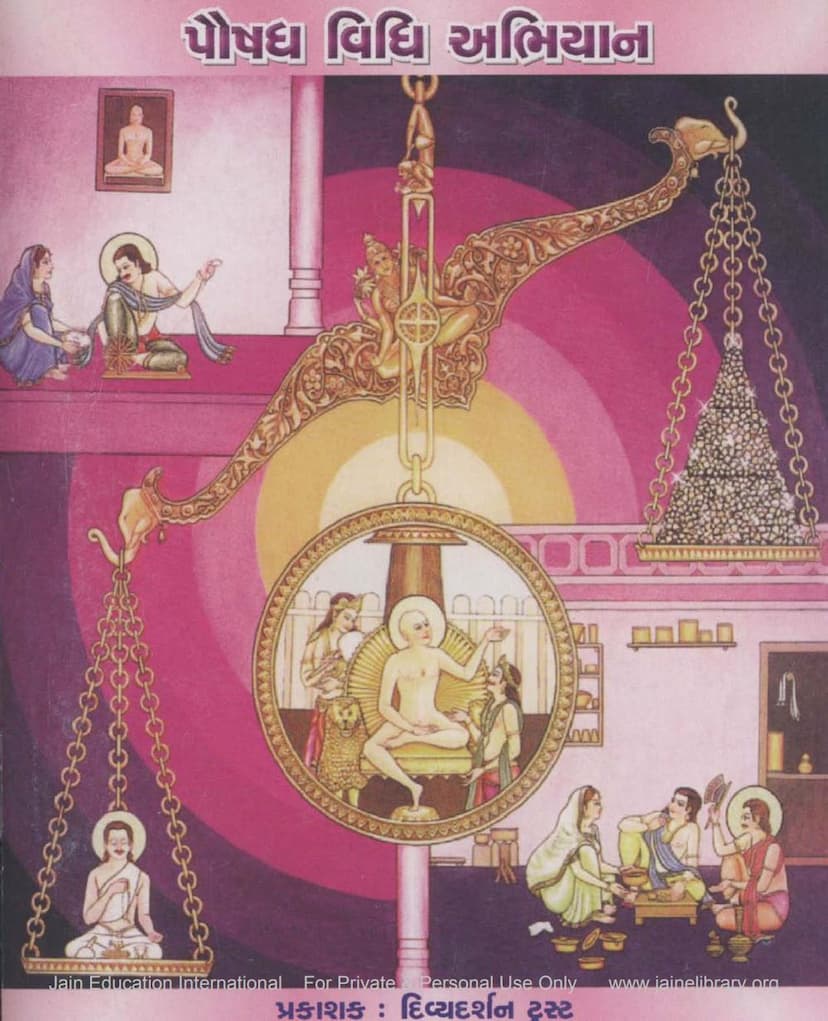Paushadh Vidhi Abhiyan
Added to library: September 2, 2025

Summary
This document is a Jain text titled "Paushadh Vidhi Abhiyan" (Study Campaign for Paushadh Vow) by Hirchandravijay and Punyavimalvijay, published by Divya Darshan Trust. It's a guide to observing the Paushadh vrata, a significant Jain vow observed by lay followers, particularly on auspicious days.
Here's a breakdown of the content:
-
Purpose: The book is dedicated to celebrating the birth centenary of Shri Bhuvanbhanusuri and the 50th anniversary of Shri Padmavijayji's ascent to heaven. It aims to guide devotees in performing the Paushadh vrata correctly.
-
What is Paushadh? It's described as the 11th vow of a Shravak (lay follower) that strengthens Dharma. It is recommended to observe a four or eight-part day fast (Paushadh) on festival days.
-
Types of Paushadh: The text outlines four types of Paushadh:
- Aahar Paushadh: Fasting (like observing a fast).
- Sharir Satkar Paushadh: Abstaining from bodily comforts like bathing and beautification.
- Brahmacharya Paushadh: Observing chastity.
- Avyapar Paushadh: Renouncing worldly and sinful activities.
-
Sequence of Observance: The book details the step-by-step procedure for observing Paushadh, which includes:
- Taking the vow before sunrise.
- Morning rituals (Padilehan - purification of essentials, Devavandan - prayer, Sajjhay - chanting/study).
- Specific prayers and recitations like "Gamanaagamane Sutra" (instead of "Saat Lakh Sutra" when moving about).
- Chaitravandan (worship of idols).
- Listening to or engaging in self-study.
- Midday and evening rituals.
- Breaking the vow (Pachkhan Paravani Vidhi).
- Evening rituals including purification and prayer.
- Preparation for sleep (Santhara Porisi).
- Morning awakening rituals and final vow breaking.
-
Specific Rituals and Prayers: The text provides the exact Gujarati prayers and mantras for various actions, including:
- Taking the Paushadh vow.
- Taking the Samayik (meditative) vow.
- Purifying (Padilehan) items like Mukhpatti (mouth cloth), clothes, and other possessions.
- Detailed explanations of the "Bols" (phrases or declarations) to be recited during purification.
- The "Gamanaagamane Sutra" which is recited during movement.
- Devavandan (worship rituals) for morning, afternoon, and evening.
- Specific Chaitravandans and Stutis (hymns) for various Tirthankaras and deities.
- Rituals for preparing a clean space for prayer (Mandala Vidhi) and resting (Santhara Porisi).
- Specific procedures for using water (Pani Sambandhi Vidhi).
- The ritual of preparing and using a purification broom (Kajo).
-
Details on Specific Prayers:
- Logass Kaussagga: This is a common Jain meditation, and the text provides the specific verses to recite.
- Namostu Arihantanam: A core Jain prayer, recited multiple times with different intentions and recitations.
- Sajjhay: Chants and devotional songs are included.
-
Types of Fasting: The text details how to perform different types of vows related to food and drink:
- Chauvihar Upvas: Abstaining from all four types of food and drink.
- Tivihar Upvas: Abstaining from specific categories of food and drink (usually excluding water or certain fruits).
- Ayambil: A specific type of fasting where food is eaten only once a day, and it consists of a particular mixture, often without spices or oil.
- Nivi, Ekasanu, Besanu: These refer to specific ways of eating or not eating, often related to the duration or type of fast.
-
Dosh (Faults): The book lists and explains faults that can be committed during Paushadh and other practices like Kaussagga (meditation) and Samayik, emphasizing how to avoid them and seek forgiveness.
-
Practical Guidelines: The text also offers practical advice on how to perform rituals correctly, such as:
- The importance of purifying items before use.
- The correct way to hold and use the Mukhpatti and Charvalo (purification tools).
- The duration of "Kaal" (time period) for which water remains pure after certain conditions are met, especially during different seasons.
- The importance of maintaining a clean environment.
- The specific practices to follow at night, especially for those observing a night-long Paushadh.
-
Concluding Prayers and Stutis: The book includes various devotional songs, prayers, and stutis for different Tirthankaras and occasions, reinforcing the devotional aspect of the Paushadh observance. These include stutis for Adinath, Parshvanath, Mahavir Swami, Neminath, Simandhar Swami, and others, as well as specific hymns for festivals like Paryushan.
In essence, "Paushadh Vidhi Abhiyan" is a comprehensive manual designed to ensure that Jains can observe the Paushadh vrata with purity, devotion, and adherence to Jain principles and rituals. It serves as a practical guide for everyday Jain practice and spiritual discipline.